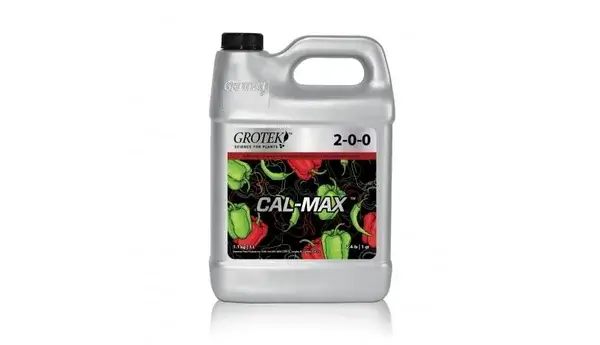- Home
- Accessories
- CalMax (Grotek) Calcium Magnesium Supplement
CalMax (Grotek) Calcium Magnesium Supplement
Description
Provides added calcium, magnesium and iron
NPK: 2-0-0
1 Litre
Recommended for hydroponic growers using coco coir. During periods of high temperatures and accelerated growth, plants can develop preventable nutrient deficiencies. Cal-Maxwas developed to provide the additional calcium, magnesium and iron needed to support peak production. Cal-Max can be used to treat problems when they surface and it can also be used as a preventative supplement to your nutrient program to avoid deficiencies such as tip burn in lettuce and blossom end rot etc.
Description
Why You Need Cal Mag in Coco
Calcium and magnesium deficiencies are the most common nutrient problem with coco grows. To avoid these problems and effectively manage your fertigation, it is important to understand the relationship that coco has with calcium and magnesium. In this article, I explain the basics of cation exchange in coco to help you understand why you need calmag supplement when growing in coco. I also provide specific instructions for when to use calmag in coco and how much calmag is needed at different times during the grow.
All cannabis fertilizers come with Calcium (Ca) and Magnesium (Mg). This leads some growers to wonder if Cal Mag supplement is really needed. However, when you are growing in coco you have to be aware that the coco itself requires a certain dose of calcium and magnesium. The cation exchange sites in coco will lock on to the Ca and Mg and render them unavailable to the plant. We must provide larger doses to ensure that there is some Ca and Mg available to the plant!
Buffering the cation exchange sites with calmag prior to use is critical. See our tutorials, “How to Prepare and Buffer Coco Coir” and “How to Reuse/Recycle Coco Coir”. However, even if you buffer the coco thoroughly, or use a pre-buffered coco product, such as Canna or Roots Organics, you should still add additional Cal Mag supplement to all irrigation water during the grow.
Understanding Cation Exchange in Coco Coir
Coco is known as a neutral grow medium, but there are cation exchange sites in coco. These sites on the surface of the coco fibers will form bonds with particular nutrient cations. The cation exchange capacity of coco is unlike soil or other grow media. There are far fewer exchanges and the exchange sites will become stable (buffered) once they attach to Ca or Mg.
The cation exchange sites in coco naturally come loaded with sodium (Na) and potassium (K) cations. However, the sites have a weak hold on the Na and K cations. In the presence of calcium (Ca) or magnesium (Mg), the sites will release their Na or K cations and lock onto the Ca or Mg. Once the cation exchange sites in coco have locked on to Ca or Mg, they are “buffered” and stay stable.
The cation exchange sites in unbuffered coco can pull nearly all the Ca and Mg out of a nutrient solution. If you try to grow cannabis plants in unbuffered coco, they will experience Ca deficiency. This is tough to correct while plants are growing because Cal Mag supplements have a strong impact on electrical conductivity (EC). As a result, the total dose of CalMag that you can provide is limited, even though it all may be going to the coco and none to the plant.
Buffering the coco in advance is a critical step to creating an ideal growing media. However, even in fully and properly buffered coco, you should continue to provide additional Cal Mag supplement.
Why do you need Cal Mag Supplement If the Coco is Buffered?
The simple answer is that the coco is constantly breaking down. As large fibers of coco break down in the pots they expose new surface areas of the coco fiber. This also exposes new cation exchange sites that will take Ca and Mg from your nutrient solution and reduce the amount available to the plant.
When to use CalMag in Coco
You should add CalMag supplement to all the irrigation water that you provide to the plant throughout the grow. When adding Cal Mag supplement, you are not adding it for your plants! You are adding it to satisfy the coco. The amount that you need to add reflects the needs of the coco, not the plant.
Coco breaks down due to a variety of factors, but you can expect it to need the most Cal Mag supplement early in the grow. The fresh coco will have the greatest potential to break apart and this is hastened by the roots of growing plants. Young plants spend much of the energy pushing their roots through the coco. As they do so, they contribute to breaking it down and create an ongoing need for additional Ca and Mg to be added. Later in the grow, as plants are flowering, the coco will have become more stable and as a result it will need less Cal Mag supplement. This is helpful, as Bloom Boosters can step in and fill the EC quota that CalMag can surrender.
How Much CalMag to Use
The specific dose required will depend on the CalMag product that you are using. Cal/Mag supplements have a strong impact on Electrical Conductivity (EC). As a result, they must be dosed carefully. The amount of Calmag that you use will limit the doses of the other nutrients that will be added.
Because CalMag has a strong impact on EC, it takes up a lot of your “EC budget”. For example, I recommend providing nutrient solution at an EC of 1100-1200 during vegetative growth. However, a full-strength dose (5ml/gal) accounts for about and EC of 800. That leaves only 300 EC left in the budget for all the other nutrients. If you are confident in your buffer, you may lower the dose to make room for other nutrients, especially late in flowering. However, some Cal/Mag supplement should be given in all nutrient solution.
[supsystic-tables id=37]


2 reviews for CalMax (Grotek) Calcium Magnesium Supplement